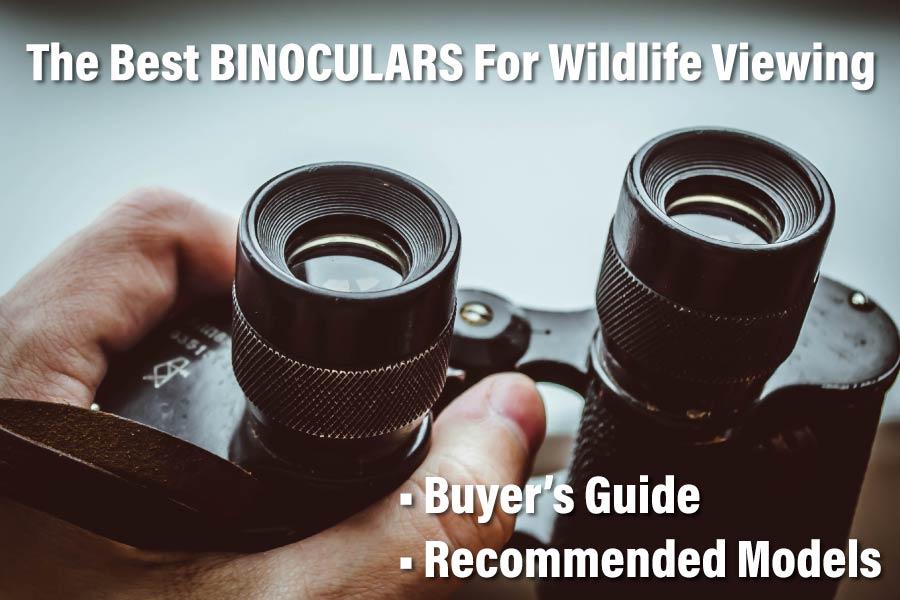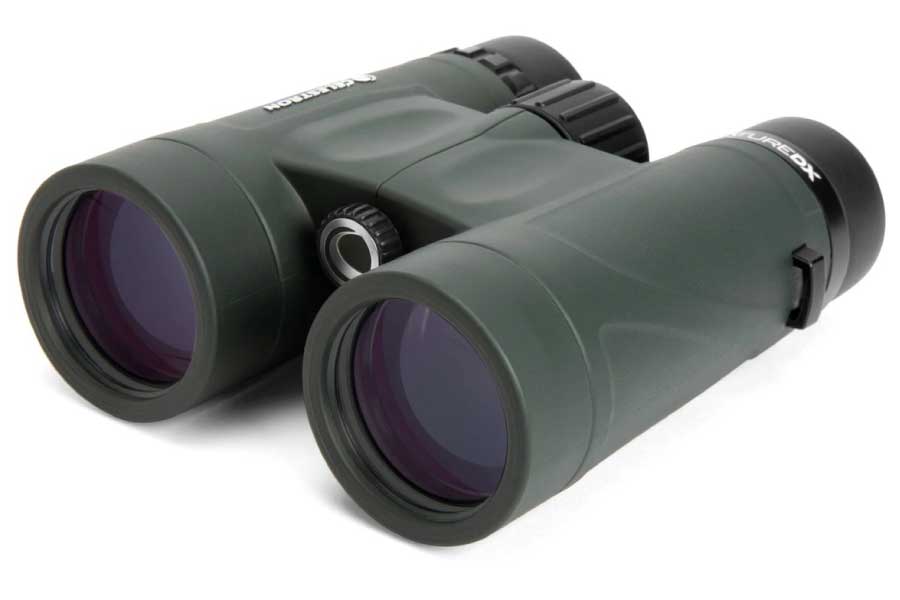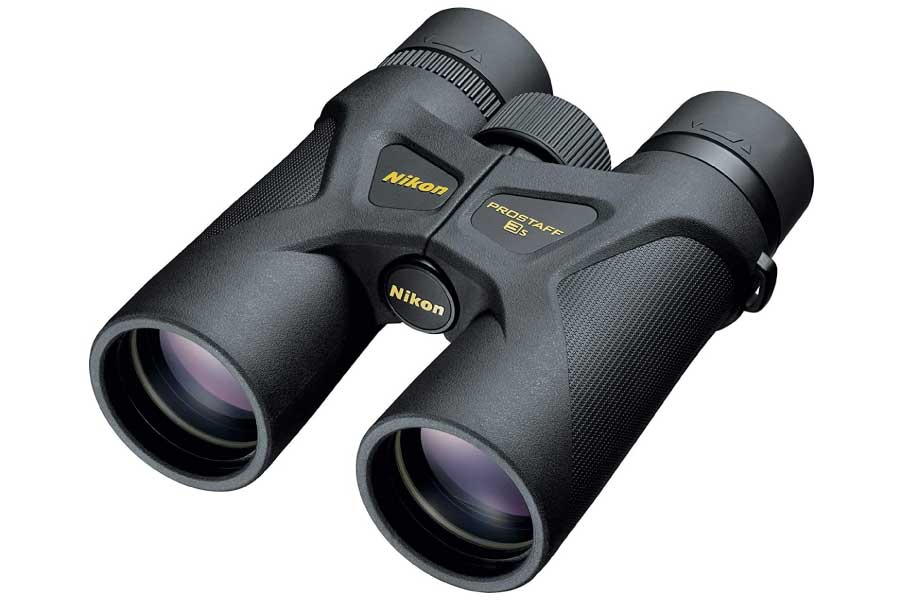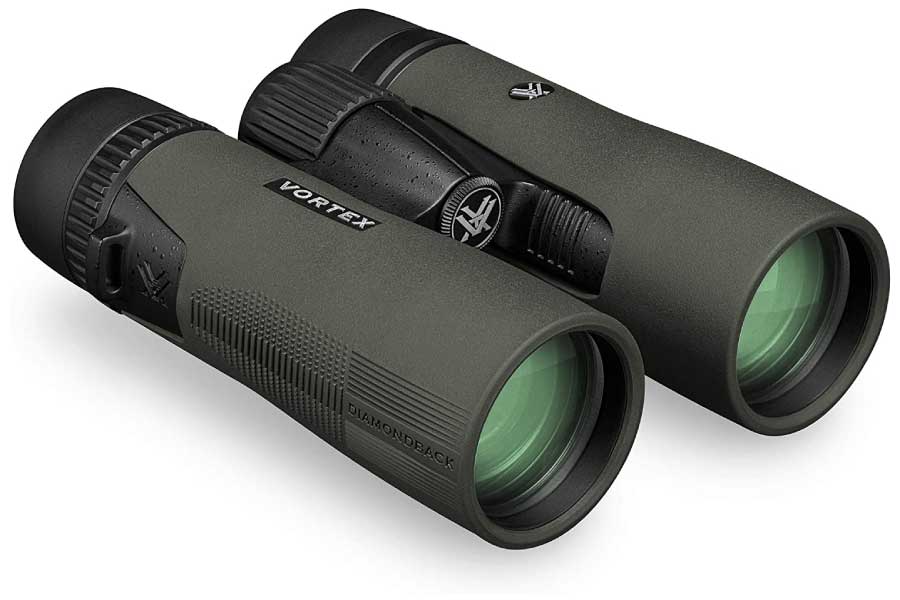A guide to choosing the best binoculars for wildlife viewing.
Page Index
- Introduction
- Recommended Binoculars For Wildlife Viewing: Top Picks
- Guide To Choosing The Best Binoculars For Wildlife Viewing
- Ideal Binocular Specifications For Wildlife Viewing
- Other Binocular Specifications
- Binoculars To Consider
Binoculars for Viewing Wildlife
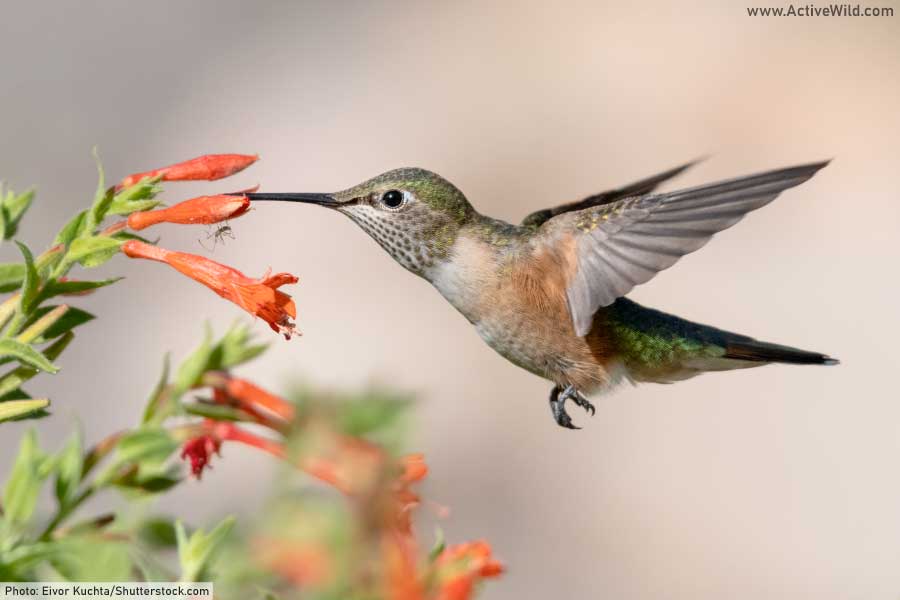
Watching wildlife is a hugely enjoyable hobby; not only does it provide you with memories to treasure, but it is also something you can do immediately, without any fancy equipment.
All you need is your eyes, your ears, and a love of the great outdoors!
With that being said, a good pair of binoculars will take your wildlife viewing to another level, whether you intend to watch birds, zebras or whales!
If you choose the right pair of binoculars at the start of your wildlife watching career, the added satisfaction they’ll provide over the years will pay back the initial cost many times over.
On this page you'll find a useful guide to choosing the best binoculars for wildlife viewing, together with suggested models that you may want to consider.
Recommended Binoculars For Wildlife Viewing: Our Top Picks
Before we get into the buying guide, here are three proven binoculars suitable for wildlife viewing:
- Price Point: Low
Celestron Outland X 8x42 / 10x42 Binoculars

A good pair of inexpensive binoculars. You may never need to upgrade!

- Price Point: Mid-High Range
Hawke Frontier ED X 8 x 42 / 10 x 42 Binoculars

Superb clarity and build quality from a respected manufacturer. We use Frontier ED X 10x42s on most of our birding expeditions. Make no mistake, these are "pro" level binoculars; improvements beyond this price point become increasingly small.

- Price Point: High
Swarovski EL 8.5 x 42 / 10x42 Binoculars

The best of the best? High-end binoculars from one of the world’s most respected optic brands. Superior image and build quality will have fellow nature lovers nodding in approval.

Guide To Choosing The Best Binoculars For Wildlife Viewing
There are two main factors you need to consider when selecting binoculars: magnification and objective lens diameter.
Luckily, there is a standard way of describing binoculars: the magnification is written first, followed by an ‘x’ multiplication symbol, followed the objective lens diameter.
For example, a pair of binoculars described as being 8 x 42 will have 8x magnification and 42mm objective lenses.
What Do These Figures Mean?
The magnification figure is easy to explain; it tells you how many times bigger the subject will appear through the binoculars.
The higher the number, the greater the magnification.
The objective lens diameter is the size of the rear lens (the lens furthest from the eyepiece) on each side of the binoculars.
The larger the objective lenses, the more light the binoculars can capture and the sharper the image will be.
Ideal Binocular Specification For Wildlife Viewing

After reading the above, you may be tempted to go out and buy binoculars with the highest magnification and biggest objective lenses you can find!
In most cases, that would be a mistake; you'd end up with binoculars that were far too heavy, and far too unstable, to be used in the field.
In general, the objective lens size determines how big (and heavy) your binoculars will be. This is something worth thinking about if your nature watching involves long hikes.
If space or weight is at a premium, then consider binoculars with an objective lens size of around 32mm, otherwise 40 or 42mm is (we feel) the ideal lens size for wildlife viewing.
Another thing to bear in mind is that inexpensive binoculars with a large objective lens size often produce a worse image than more expensive binoculars with a smaller lens size.
The downside to having a large magnification is that the higher the magnification, the harder it is to keep the image steady.
You may get a larger image, but your own movements will also be magnified, making it harder to pick out detail in the image.
In general, binoculars with a magnification of over 12x are difficult to hold steady and are best used with a tripod.
Additionally, the higher the magnification, the smaller the area you'll be able to see through your binoculars.
This is fine if you’ve already found your subject and can keep it in view, but not so good if you’re trying to locate your subject while looking through your binoculars.
Imaging you're looking up into the branches of a tree in the hope of seeing a bird that is singing. Having a high magnification might mean that you get great, close-up images of the branches, but you might have difficulty actually locating the bird!
Recommended Magnification and Lens Size For Wildlife Viewing

So, what are the best binoculars for wildlife viewing?
As with many things in life, the key is finding a happy medium, so aim to get binoculars that will suit the majority of your wildlife viewing.
Binoculars with a magnification of either 8 or 10, and a lens size of 40 or 42, are generally considered to be the most suitable for viewing wildlife.
With these magnifications and lens sizes, most binoculars are light enough to be used for long sessions, and will provide the best balance between viewing area and magnification.
8x or 10x Binocular Magnification?
Go for 8x magnification if you regularly look at subjects that are either relatively close, fast moving, or difficult to spot.
Go for 10x magnification if you want more close-up detail at the expense of a (slightly) smaller viewing area and (slightly) less image stability, or if you look at subjects that tend to be quite far away.
Don't lose too much sleep over the 8x / 10x decision! The difference between magnifications is small. We use 10x; many other birders / wildlife watchers use 8x!
Our recommended binoculars, below, are all within these recommended magnification and objective lens sizes.
Other Binocular Specifications
There are a few other factors you may want to consider when choosing your new binoculars. Listed below are some of the other figures commonly provided by manufacturers.
Field of View (FOV)
The field of view (FOV) of a pair of binoculars is the area covered by the image you can see through the lenses.
The FOV is usually given as an angle (the greater the angle, the greater the field of view).
Some manufacturers provide this measurement in feet or meters at a certain range (e.g. 138m at 1,000m, which means the area you’ll see through the eyepieces will be 138m wide at a range of 1,000 meters).
In general, the larger the magnification, the smaller the FOV.
Cheap binoculars with a large field of view may suffer from distortion at the edges of the image.
Eye Relief
Eye relief is the maximum distance your eye can be from the eyepiece and still see a fully-clear image. This is an important consideration for those who need to wear glasses while using their binoculars.
Those who wish to wear spectacles while using binoculars should aim for an eye relief measurement of at least 15 mm.
Many binoculars have adjustable eyepieces, which allow them to be used either with or without spectacles. Move them in if you don't wear glasses, and out if you do.
Wearing glasses is generally not necessary when using binoculars, unless you suffer from astigmatism.
Close Focus / Closest Focus
This is simply the shortest distance at which a subject can be observed while remaining in focus. This isn’t the most important figure to consider when choosing a pair of binoculars, but you may want to bear it in mind if you’ll be using your binoculars to look at subjects that are close to you, such as wild flowers or insects.
IPD / Interpupillary Distance
This is the space between the centers of your pupils. The average person’s IPD is 64mm. If your eyes are spaced either very close together or very far apart, then check to see if the binoculars you are considering will match your IPD.
The Best Binoculars For Wildlife Viewing: Models To Consider
Now you have all the information you need to be able to select a suitable pair of binoculars. Below is a list of binoculars that you may want to consider.
All of the binoculars in the list below are either 8x or 10x magnification. Most models are available in either magnification; the binoculars you choose should reflect the type of wildlife viewing you are most likely to use them for.
The specs we’ve provided are for the model featured (i.e. 8x or 10x). You can click on the links to find the specification and price of the model in which you’re interested.
If you decide to make a purchase after using the links, we may receive a small commission.
Celestron – Outland X 10x42 Binoculars
A well-regarded pair of binoculars offering good value for money.
- Size: 146mm x 126mm x 53mm (5.75" x 4.96" x 2.08")
- Weight: 21.8 oz (618 g)
Features:
- Multi-Coated Optics
- Waterproof and Fogproof
- Protective Rubber Covering
- Twist-up Eyecups for Quick Adjustment
(Source)
Get prices and see reviews at Amazon:
Celestron Nature DX 8x42 Binoculars
Good-looking mid-range binoculars with professional features.
- Size: 135mm x 126mm x 52mm (5.3" x 4.9" x 2")
- Weight: 22.2 oz (629 g)
Features:
- Waterproof and fully rubber armored.
- Phase coated BaK-4 prisms for increased contrast and resolution.
- Fully multi-coated optics provide brighter images by increasing light transmission through the entire optical path.
- Close focus of 6.5 feet for viewing nearby subjects.
- Sturdy, twist-up eyecups with multiple stops.
- Eyeglass friendly with 17.5 mm of eye relief.
(Source)
Get prices and see reviews at Amazon:
Nikon Prostaff 3S 10x42 Binoculars
Good-quality mid-price binoculars from a trusted manufacturer of optical products.
- Size: 5.9 x 5.1 x 2.0 in. / 150 x 130 x 52 mm
- Weight: 575g/20.3oz
Features:
- Compact and lightweight
- Waterproof and fog-free
- Multilayer-coated lenses and high-reflectivity prism coating
(Source)
Get prices and see reviews at Amazon:
Vortex Optics Diamondback HD 8x42 Binoculars
Good quality binoculars for those wishing to spend a little more.
- Size: 5.1 x 5.7 inches / 130 x 145 mm
- Weight: 21.8 oz / 618 g
Features:
- Fully Multi-Coated Increase light transmission with multiple anti-reflective coatings on all air-to-glass surfaces.
- Ultra-hard, scratch-resistant coating protects exterior lenses from scratches, oil and dirt.
- Rubber Armor Provides a secure, non-slip grip, and durable external protection.
- Waterproof O-ring seals prevent moisture, dust and debris from penetrating the binocular for reliable performance in all environments.
- Fogproof Argon gas purging prevents internal fogging over a wide range of temperatures.
- Roof Prism Valued for greater durability and a more compact size.
- Adjustable Eyecups Twist up and down for comfortable viewing with or without eyeglasses.
(Source)
Get prices and see reviews at Amazon:
Hawke Frontier ED X Binoculars 8x42
Our pick of the bunch at this price point. Spending more will only get you small improvements.
- Size: 5.5 x 4.1-4.8" / 105-123 x 140 mm
- Weight: 24.4oz / 692g
Features:
- Extra-low Dispersion glass for optimum clarity
- Dielectric Coatings provide increased light reflectivity
- Fully Multi-Coated optics to produce sharp images
- Focus knob with 1.5 turn - close focus 6.6ft/2m
- High resolution Phase Corrected BAK-4 roof prisms
- Water repellent coating on objective lenses
- Lightweight rubber coated magnesium alloy chassis
- Stay-on lens covers for maximum lens protection
- Replaceable twist-up eye cups with position stops
(Source)
Get prices and see reviews at Amazon:
Nikon Monarch HG 10X42 Binoculars
High-quality, professional-level binoculars from a world-respected brand.
- Size: 5.7 x 5.2 in / 144.78 x 132.08 mm
- Weight: 24 oz. / 680g
Features:
- High-quality multilayer coating applied to all lenses and prisms to improve light transmission
- Highly reflective dielectric multilayer coating applied to the roof prism to enhance light reflection. (This produces an exceptionally bright view of up to 92% or higher light transmittance.)
- Durable magnesium alloy body
- Scratch-resistant lens coating
- Waterproof to a depth of up to 5 m for as long as 10 minutes.
- Nitrogen-filled body gives superior waterproof performance
- Internal fogging is prevented inside the optical system even in low-pressure environments up to an altitude of 5,000 m equivalent
- Turn-and-slide rubber eyecups make it easy to position your eyes at the correct eye-point.
- Integrated objective lens caps so you never need to worry about losing them.
(Source)
Get prices and see reviews at Amazon:
ZEISS Conquest HD 10x42 Binoculars
Together with Swarofski, Zeiss are perhaps the most well-respected manufacturers of binoculars today. The Conquest HD will provide a lifetime of wildlife viewing pleasure.
- Size: 4.7 x 5.9 " / 120 mm x 150 mm
- Weight: 28.0 oz (795 g)
Features:
- Compact size, low weight and robust body construction
- Higher definition glass produces 90% to-the-eye light transmission, great low-light performance and excellent target resolution across the entire magnification range.
- Coated lenses
- Large field of view
- Rotating, lockable eyecups
(Source)
Get prices and see reviews at Amazon:
Vortex Optics Razor HD Roof Prism 10x42 Binoculars
Ultra-high image quality and rugged construction. You'll probably never need another pair of binoculars
- Size: 5.1 x 5.9 inches / 130 x 150 mm
- Weight: 24.8 oz / 703 g
Features:
- HD Lens Elements Premium extra-low dispersion glass delivers the ultimate in resolution and color fidelity, resulting in high-definition images.
- XR™ Plus Fully Multi-Coated Ultimate anti-reflective coatings on all air-to-glass surfaces provide maximum light transmission for peak clarity and the pinnacle of low-light performance.
- Dielectric Coating Multi-layer prism coatings provide bright, clear, color-accurate images.
- Roof Prism Valued for greater durability and a more compact size.
- Magnesium Chassis Decreases weight and increases strength.
- Waterproof O-ring seals prevent moisture, dust and debris from penetrating the binocular for reliable performance in all environments.
- Fogproof Argon gas purging prevents internal fogging over a wide range of temperatures.
- ArmorTek ® Ultra-hard, scratch-resistant coating protects exterior lenses from scratches, oil and dirt.
- Rubber Armor Provides a secure, non-slip grip, and durable external protection.
- Adjustable Eyecups Twist up and down for comfortable viewing with or without eyeglasses.
(Source)
Get prices and see reviews at Amazon:
Swarovski EL 10x42 Binoculars
No list of the best binoculars for wildlife viewing would be complete without a pair of Swarovskis. Known throughout the world for their quality, these may well be the ultimate wildlife binoculars, but they come at a price.
- Size: 5.4 x 6.5 x 3.2 in. / 137 x 166 x 81 mm
- Weight: 31.6 oz / 895 g
Features:
- Expansive field of view
- Integrated objective lens and eyepiece covers
- Razor-sharp images
- Precise range and angle measurement
(Source)
Get prices and see reviews at Amazon:
Best Binoculars For Wildlife Viewing: Conclusion
We hope that this guide has been helpful for you if you are considering getting a new pair of binoculars. Although wildlife watching can be enjoyed with little or no equipment, it's made even better with a good pair of binoculars!
If you have any personal binocular recommendations, hints or tips, then please let us know in the comments section below!

